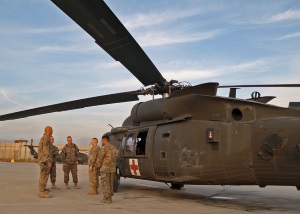Courtesy Story by: Sgt. Courtney Champagne
 Photo By Jet Fabara | Flight medics talk with their leadership following an awards ceremony held for the 389th Engineer Company, 368th Engineer Battalion, 176th Engineer Brigade, for the construction of a new MEDVAC facility in Bagram Air Field, Afghanistan. The facility will house members of Charlie Company, 2nd Battalion, 1st Aviation Regiment (General Support Aviation Battalion) from Ft. Riley, Kan. (“Boomer Dust-off”). (DOD photo by Jet Fabara)
Photo By Jet Fabara | Flight medics talk with their leadership following an awards ceremony held for the 389th Engineer Company, 368th Engineer Battalion, 176th Engineer Brigade, for the construction of a new MEDVAC facility in Bagram Air Field, Afghanistan. The facility will house members of Charlie Company, 2nd Battalion, 1st Aviation Regiment (General Support Aviation Battalion) from Ft. Riley, Kan. (“Boomer Dust-off”). (DOD photo by Jet Fabara)
BAGRAM AIR FIELD, Afghanistan – The MEDEVAC facility at Bagram Air Field in northern Afghanistan has seen better days. Its shattered windows, leaning walls, and peeling paint serve as evidence of the building’s lengthy history.
The old hangar was constructed in the 1950s for the Afghan people by the U.S. Government in an effort to impede the spread of communism in Asia.
During the Invasion of the Soviet Union in Afghanistan in 1979, it was inhabited by Russian forces until they withdrew in 1989, after which the Taliban maintained domination of the location that the old hangar was built on.
In 2002, Bagram Air Field became home to American forces as part of the US-led invasion of Afghanistan, and the hangar became the workspace for hundreds of medical evacuation (MEDEVAC) crews, providing them with administrative offices as well as break, maintenance, and storage spaces which are critical for successful MEDEVAC operations.
The primary mission of Charlie Company, 2nd Battalion, 1st Aviation Regiment (General Support Aviation Battalion) from Ft. Riley, Kansas (“Boomer Dust-off”) is to save lives by providing MEDEVAC from the frontlines of conflicts in Afghanistan to the medical facility at Bagram Air Field.
The GSAB mission is vital to the overall success of operations in Afghanistan; ensuring Soldiers and Afghan Nationals are provided with swift medical attention after sustaining battlefield injuries.
In the spring of 2016, the 389th Engineer Company a U.S. Army Reserve unit from Middletown, Iowa teamed up with C. Co., 2-1 GSAB to coordinate the build-out of a new MEDEVAC facility. The aging hanger required replacement to address safety concerns and provide a new facility that met standard operating requirements.
The Base Support Group Commander, Col. G. Shawn Wells Jr. ordered the hangar’s evacuation due to overall structural instability however it became an urgent necessity to figure out where MEDEVAC crews would now conduct operations.
A large area maintenance (LAM) tent was placed nearby as a short-term solution. Although the LAM tent provided a covered space for the crew to operate in, it lacked space for administrative offices and break areas, as well as maintenance and equipment storage. It hardly met the crew’s needs as a sensible area of operation.
The 389th Engineer Company rose to the occasion and immediately began the early design plans to create a work space worthy of Boomer Dust-off as well as future MEDEVAC crews and their missions.
The MEDEVAC crews must be prepared to respond to emergencies at any time, spending long hours in their work spaces on standby. Special considerations were taken into account when weighing the design options of the new structure within the LAM tent.
The final design was a collective effort amongst Boomer Dust-off personnel, Joint Engineering (JENG) at Bagram Air Field, the Forward Engineer Support Team (FEST-A), the 368th Engineer Battalion’s Construction Management Section, and the 389th Engineer Company.
A crew of 14 Soldiers were selected to complete the build-out based on their carpentry expertise. Their skills were immediately evident based on their productivity. Only three days into the job, they were an entire day ahead of schedule.
“This is one project that is going to have a lasting impact here,” said Spc. Kevin R. Suzie, carpentry and masonry specialist with the 389th Engineer Company.
The end result included crafted trimming, cut and placed balusters, and sections of spacious rooms.
“Their attention to detail was remarkable”, said Lt. Col. Matthew J. Strub, Deputy Commander of Task Force Victory.
The completed project was executed in just under three weeks. It included creative design solutions to the customer’s specific conditions, including adequate space for storage of a UH-60 Blackhawk aircraft during maintenance and repair.
“We got to test our skills. We got to make design changes and use creativity”, said Sgt. Kent A. Hortstman, carpentry and masonry specialist with the 389th Engineer Company.
The 1st Combat Aviation Brigade hosted a ribbon cutting ceremony on November 10, 2016 honoring both the critical service of the Soldiers of C Co., 2-1 GASB, and the key role of the 389th Engineer Company throughout the construction of the new facility.
During the ceremony, 1st CAB Commander Col. John M. Cyrulik and Command Sgt. Maj. Roque R. Quichocho presented Soldiers of the 389th with impact awards for their indispensable contribution to current and future MEDEVAC missions.
Afterwards, leaders conducted a field expedient ribbon cutting in the new facility, in true MEDEVAC style, using trauma shears to cut the ribbon.
“No other force on the planet goes to the extent that we do to make sure no Soldier gets left behind. This collaboration provides the capability to save lives,” said Cyrulik.
The highly-skilled and dedicated Soldiers of the 389th provided a site for hundreds of MEDEVAC crews to proudly call their own today, and for many years to come.
“At the end of the day, nothing gets done without the nuclear fuel that is our Soldiers,” said Cyrulik.
The 389th is a U.S. Army Reserve unit on a nine-month deployment. The unit is assigned to the 368th Engineer Battalion, and the 176th Engineer Brigade, Task Force Chaos.